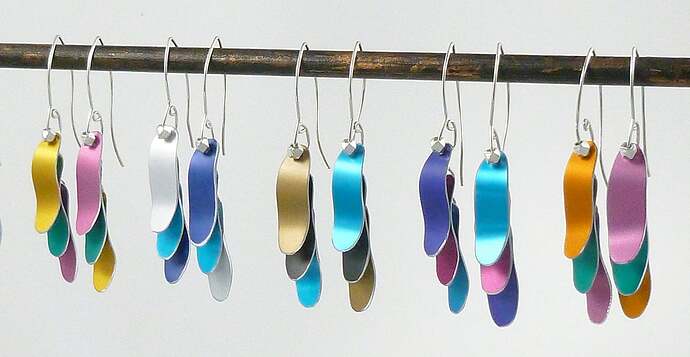Materials: aluminum, sterling, fine silver
Dimensions: They measure about 1.75 inches from the top of the ear wire to the bottom of the waves.
Formed around dowels
Photo credit: barbara gross
Barbara Gross
Benjamina
Weston, MA. USA
Barbara's background in the arts began as a dancer with a small modern dance company in NYC. As a student of the Martha Graham technique, she learned how the body moves through space. One movement transitioning to the next with effortless grace. Her designs and energy reflects the same passion she approached dance. Simplicity of movement and design.
"My work is an expression of discovery using metal as a medium inspired by great art, architecture and nature. The designs flow into my mind as I work with the metal shaping, weaving and forging. The end result is as surprising as the start."
Barbara's work has been seen in small jewelry galleries in Maine and Massachusetts. Her work has also been seen in featured shows and juried art galleries such as; DeCordova Museum Student Shows MA, Karenna Maraj Collection Belmont, MA, Once in a Blue Moon Martha's Vineyard, MA, Vine and Cupboard Bethel, ME, Sign of the Dove - Chestnut Hill Mall, MA
Barbara has studied with notable Goldsmiths such as; Munya Abagail Upin, Cynthia Eid, Paulette Werger, Jayne Redman, Charles Lewton-Brain, Michael Good, Metalwerx, DeCordova Museum School
The exhibition explores metal works whose primary theme is color embraced as their primary visual focus, whether that be using colored materials, exploring creating colored surfaces, or encasing the object in color.
As the world's largest jewelry related internet site, Ganoksin strives to develop exhibitions showcasing work from around the world. This exhibition was open to all metalsmiths, professional and amateur, advanced and beginner.
In total 303 artists contributed 814 show pieces for the permanent online exhibition.
The exhibition was curated by Beth Wicker, President of the North Carolina Society of Goldsmiths in the United States, and Adjunct Instructor at Northeastern Technical College in South Carolina. Director of the exhibition is Hanuman Aspler, founder of The Ganoksin Project, the world's largest internet jewelry site.
Hue is one of the primary properties of color, it refers to the place the color occupies on the visual spectrum. Humans have used hues throughout time, to create cave paintings, to decorate themselves, their clothing and their housing.
Different hues have taken on different meanings throughout time. Gold traditionally has been a color of purity - the metal gold is relatively unchangeable, and the hue of gold has come to stand for gods and goddesses, for royalty, for durability and for purity. Red has often meant love, or passion. Hues often reflect the meaning of the seasons, with pastels referring to spring and the burst of new life after the pale hues of winter. Summer is reflected in vibrant, deep hues, followed by the browning of hues in the fall as plants go to seed and die, and the land turns fallow.
The worth of a hue has often been tied to what is necessary to make the pigment that creates the hue, and the expensive involved in the process. Often created from crushed stones that had to be mined and carried by caravan over thousands of miles, or from fermented roots of plants only grown in certain areas, or the carapaces of rare insects - the creation of hue in a way that could be used by man was an involved and generally expensive process.
In today's world metalsmiths have access to perhaps the widest range of materials and hues in the history of man - and in some of the most affordable ways ever.
This exhibition celebrates hue - color - as an integral, inherent element of the work. We talk of the "richness" of color, and examples of this abound here. One expects hues from the colors of gemstones used in metalsmithing, but we also have hues from some less expected places. Glass enamels are an ancient way of adding color, as are a variety of patinas. Today's artists also use synthetic man-made materials to add color in ways that didn't exist a century ago.
We invite you to enjoy this celebration of hue, and the ways hues and their use have changed over time.
